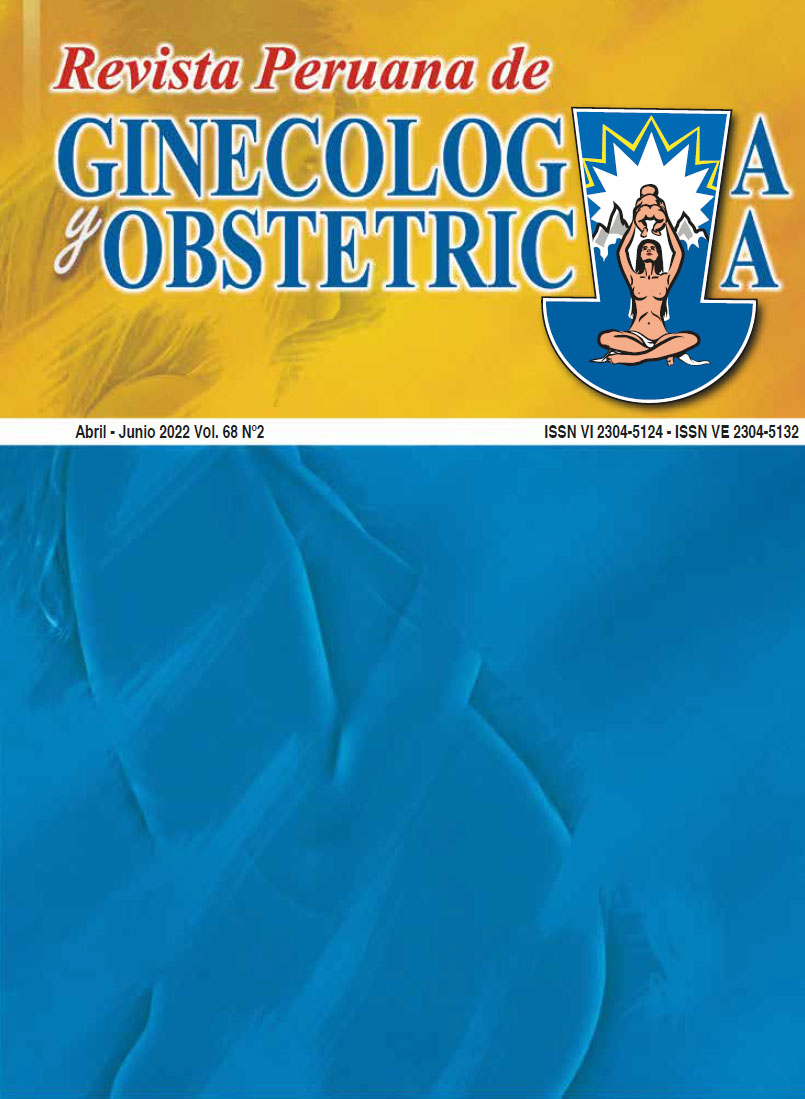Higroma quístico retronucal como marcador de anomalías cromosómicas en el primer trimestre de la gestación - Actualización
DOI:
https://doi.org/10.31403/rpgo.v68i2423Palabras clave:
Higroma quístico retronucal, Translucencia nucal tabicada, Biopsia de vellosidades coriales, Amniocentesis, Aberraciones cromosómicasResumen
Objetivo. Evaluar la asociación del higroma quístico retronucal (HQR) y anomalías cromosómicas
fetales. Métodos. Estudio observacional retrospectivo de 323 fetos del primer trimestre con riesgo
para anomalías cromosómicas diagnosticados por ecografía entre las 11 y 13,6 semanas. Resultados.
De 323 fetos con riesgo para anomalías cromosómicas, se encontró 132 casos de anomalías
cromosómicas (40,9%). Se identificaron 145 casos de HQR; en 64 (56,6%) se realizó biopsia de
vellosidades coriales y en 81 (43,5%) amniocentesis, hallándose cariotipo anómalo en 82 (56,6%). De
88 fetos con HQR aislado, 33 casos (37,5%) tuvieron alguna anomalía cromosómica; en 58 fetos con
HQR asociado a otros hallazgos anormales, se encontró que en 43 fetos (74,1%) hubo anomalías
cromosómicas, y de ellos 24 (41,4%) tenían onda de flujo (OVF) anormal del ductus venoso, 17
(29,3%) tenían edema generalizado, 8 casos (13,8%) con cardiopatía, 7 (12,1%) ausencia del hueso
nasal. Los valores predictivos del HQR fueron: sensibilidad (S) 62,1%, especificidad (E) 67%, valor
predictivo positivo (VPP) 56,6%, valor predictivo negativo (VPN) 71,9%, p<0,001, OR: 3,3. El HQR
asociado a otros hallazgos anormales, tuvo los siguientes valores predictivos: S 52,4%, E 76,2%, VPP
76,2%, OR: 3,5, LR+: 2,2, p<0,000. El edema generalizado y el ductus venoso anormal tuvieron los
valores predictivos más altos: VPP 88,2% y 83,3%, respectivamente. Las anomalías cromosómicas
encontradas con mayor frecuencia fueron: T21 (53,7%), monosomía X (18,3%), T18 (15,9%), T13
(6,1%). Conclusiones. El higroma quístico retronucal es un marcador de riesgo con alto valor
predictivo para anomalías cromosómicas, siendo mayor cuando está asociado a otros hallazgos
ecográficos anormales. La identificación ecográfica del HQR en el tamizaje prenatal del primer
trimestre debería ser indicación para recomendar una prueba diagnóstica para anomalías
cromosómicas.
Descargas
Descargas
Publicado
Versiones
- 2022-07-11 (2)
- 2022-07-06 (1)
Cómo citar
Número
Sección
Licencia
Derechos de autor 2022 Moisés Huamán Guerrero, José Pacheco Romero, Lourdes Espinoza Llanos, Moisés Huamán Joo, Alicia Díaz Kuan

Esta obra está bajo una licencia internacional Creative Commons Atribución 4.0.
Esta revista provee acceso libre inmediato a su contenido bajo el principio de que hacer disponible gratuitamente la investigación al publico, lo cual fomenta un mayor intercambio de conocimiento global.















